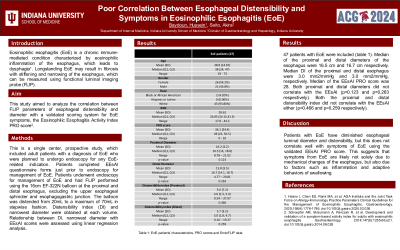Sunday Poster Session
Category: Esophagus
P0522 - Poor Correlation Between Esophageal Distensibility and Symptoms in Eosinophilic Esophagitis (EoE)
Sunday, October 27, 2024
3:30 PM - 7:00 PM ET
Location: Exhibit Hall E

Has Audio

Hussein Baydoun, MD
Indiana University
Indianapolis, IN
Presenting Author(s)
Hussein Baydoun, MD, Akira Saito, MD
Indiana University, Indianapolis, IN
Introduction: Eosinophilic esophagitis (EoE) is a chronic immune-mediated condition characterized by eosinophilic inflammation of the esophagus., which leads to dysphagia. Longstanding EoE may result in fibrosis with stiffening and narrowing of the esophagus, which can be measured using functional luminal imaging probe (FLIP). This study aimed to analyze the correlation between FLIP parameters of esophageal distensibility and diameter with a validated scoring system for EoE symptoms, the Eosinophilic Esophagitis Activity Index PRO score.
Methods: This is a single center, prospective study, which included adult patients with a diagnosis of EoE who were planned to undergo endoscopy for any EoE-related indication. Patients completed EEsAI questionnaire forms just prior to endoscopy for management of EoE. Patients underwent endoscopy for management of EoE and had FLIP performed using the 16cm EF-322N balloon at the proximal and distal esophagus, excluding the upper esophageal sphincter and esophagogastric junction. The balloon was distended from 20mL to a maximum of 70mL in stepwise fashion. Distensibility index (DI) and narrowest diameter were obtained at each volume. Relationship between DI, narrowest diameter with EEsAI scores were assessed using linear regression analysis.
Results: 47 patients with EoE were included (table 1). Median of the proximal and distal diameters of the esophagus were 16.5 cm and 16.7 cm respectively. Median DI of the proximal and distal esophagus were 3.0 mm2/mmHg and 3.0 mm2/mmHg, respectively. Median of the EEsAI PRO score was 28. Both proximal and distal diameters did not correlate with the EEsAI (p=0.123 and p=0.263 respectively). Both the proximal and distal distensibility index did not correlate with the EEsAI either (p=0.466 and p=0.259 respectively).
Discussion: Patients with EoE have diminished esophageal luminal diameter and distensibility, but this does not correlate well with symptoms of EoE using the validated EEsAI PRO score. This suggests that symptoms from EoE are likely not solely due to mechanical changes of the esophagus, but also due to factors such as inflammation and adaptive behaviors of swallowing.
Note: The table for this abstract can be viewed in the ePoster Gallery section of the ACG 2024 ePoster Site or in The American Journal of Gastroenterology's abstract supplement issue, both of which will be available starting October 27, 2024.
Disclosures:
Hussein Baydoun, MD, Akira Saito, MD. P0522 - Poor Correlation Between Esophageal Distensibility and Symptoms in Eosinophilic Esophagitis (EoE), ACG 2024 Annual Scientific Meeting Abstracts. Philadelphia, PA: American College of Gastroenterology.
Indiana University, Indianapolis, IN
Introduction: Eosinophilic esophagitis (EoE) is a chronic immune-mediated condition characterized by eosinophilic inflammation of the esophagus., which leads to dysphagia. Longstanding EoE may result in fibrosis with stiffening and narrowing of the esophagus, which can be measured using functional luminal imaging probe (FLIP). This study aimed to analyze the correlation between FLIP parameters of esophageal distensibility and diameter with a validated scoring system for EoE symptoms, the Eosinophilic Esophagitis Activity Index PRO score.
Methods: This is a single center, prospective study, which included adult patients with a diagnosis of EoE who were planned to undergo endoscopy for any EoE-related indication. Patients completed EEsAI questionnaire forms just prior to endoscopy for management of EoE. Patients underwent endoscopy for management of EoE and had FLIP performed using the 16cm EF-322N balloon at the proximal and distal esophagus, excluding the upper esophageal sphincter and esophagogastric junction. The balloon was distended from 20mL to a maximum of 70mL in stepwise fashion. Distensibility index (DI) and narrowest diameter were obtained at each volume. Relationship between DI, narrowest diameter with EEsAI scores were assessed using linear regression analysis.
Results: 47 patients with EoE were included (table 1). Median of the proximal and distal diameters of the esophagus were 16.5 cm and 16.7 cm respectively. Median DI of the proximal and distal esophagus were 3.0 mm2/mmHg and 3.0 mm2/mmHg, respectively. Median of the EEsAI PRO score was 28. Both proximal and distal diameters did not correlate with the EEsAI (p=0.123 and p=0.263 respectively). Both the proximal and distal distensibility index did not correlate with the EEsAI either (p=0.466 and p=0.259 respectively).
Discussion: Patients with EoE have diminished esophageal luminal diameter and distensibility, but this does not correlate well with symptoms of EoE using the validated EEsAI PRO score. This suggests that symptoms from EoE are likely not solely due to mechanical changes of the esophagus, but also due to factors such as inflammation and adaptive behaviors of swallowing.
Note: The table for this abstract can be viewed in the ePoster Gallery section of the ACG 2024 ePoster Site or in The American Journal of Gastroenterology's abstract supplement issue, both of which will be available starting October 27, 2024.
Disclosures:
Hussein Baydoun indicated no relevant financial relationships.
Akira Saito indicated no relevant financial relationships.
Hussein Baydoun, MD, Akira Saito, MD. P0522 - Poor Correlation Between Esophageal Distensibility and Symptoms in Eosinophilic Esophagitis (EoE), ACG 2024 Annual Scientific Meeting Abstracts. Philadelphia, PA: American College of Gastroenterology.
